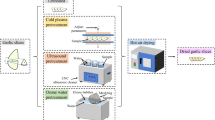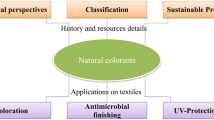Abstract
Thermogravimetry coupled with differential scanning calorimetry (TG–DSC) has been commonly used in the field of conservation of Cultural Heritage for the study of art objects, especially for the characterisation of inorganic matrixes. In recent years, thermal analyses have been applied to the study of organic painting materials. The advantages of performing TG–DSC are linked to the fact that it is micro-destructive technique which does not require any treatment prior the analysis and provide useful information in relatively short time. The aim of this study is to describe the application of TG–DSC on the study of oil binders used in contemporary paints. Even if synthetic binders have become increasingly popular in the 20th century, many contemporary artists still prefer the more traditional media: drying oils. Although the wish of recalling traditional methods, much practical knowledge in paint preparation by mixing drying oil and pigments and in the behaviour of the mixture has been lost. This is mainly due to the different composition of contemporary materials in comparison with the traditional ones and may sometimes lead to different drying properties of the oil paint formulations and consequent problems in the art creation and conservation. For answer to this artistic need and in particular to the difficulties outlined by artists themselves in producing and employing oil paints, unpigmented and pigmented oil films were studied after a week, 1 and 2 years of natural drying under laboratory conditions. Thermal analyses were performed in air flow: the focus of this research was, in fact, to study the thermal and oxidative behaviours of young films for better understanding the very first processes leading to the formation of the film.









Similar content being viewed by others
References
Vasari G. Le vite de più eccellenti architetti, pittori et scultori italiani. Torino: Einaudi; 1986.
Learner TJS. Analysis of modern paints. Los Angeles: Getty Publications; 2004.
Pugliese M. I materiali sintetici nell’arte contemporanea. Kermes. 1997;30:21–30.
Jones FN, Mao W, Ziemer PD, Xiao F, Hayes J, Golden M. Artist paints—an overview and preliminary studies durability. Prog Org Coat. 2005;52:9–20.
Pires J, Cruz AJ. Thecniques of thermal analysis applied to the study of cultural heritage. J Therm Anal Calorim. 2007;87:411–5.
Erhardt D, Tumosa CS, Mecklenburg MF. Long-term chemical and physical processes in oil paint films. Stud Conserv. 2005;50:143–50.
Odlyha M. Investigation of the binding media of paintings by thermoanalytical and spectroscopic techniques. Thermochim Acta. 1995;269–270:705–27.
Burmester A. Investigation of paint media by differential scanning calorimetry (DSC). Stud Conserv. 1992;37:73–81.
Lazzari M, Chiantore O. Drying and oxidative degradation of linseed oil. Polym Degrad Stab. 1999;65:303–13.
Rudnik E, Szczucinska A, Gwardiak H, Szulc A, Winiarska A. Comparative studies of oxidative stability of linseed oil. Thermochim Acta. 2001;370:135–40.
Prati S, Chiavari G, Cam D. DSC application in the conservation field. J Therm Anal Calorim. 2001;66:315–27.
Le Parlouer P. Simultaneous TG-DSG: a new technique for thermal analysis. Thermochim Acta. 1987;121:307–22.
Thomas PS, Stuart BH, McGowan N, Guerbois JP, Berkahn M, Daniel V. A study of ochres from an Australian aboriginal bark painting using thermal methods. J Therm Anal Calorim. 2011;103:1336–9.
White RE, Thomas PS, Phillips MR, Wuhrer R. A DSC study of the effect of lead pigments on the drying of cold pressed linseed oil. J Therm Anal Calorim. 2005;80:237–9.
Bonaduce I, Carlyle L, Colombini MP, Duce C, Ferrari C, Mazzeo R, Prati S, Ribechini E, Selleri P, Tiné MR, Tombari E, Townsend JH. Study on binding media in oil paintings: characterisation of linseed oil by DEMS, TGA and GC-MS. In: Proceedings of ICOM-CC, Interim meeting Scientific Research Working Group, Pisa, 7–8 October 2010; p. 16.
Wexler H. Polymerization of drying oils. Chem Rev. 1964;64:591–611.
Mayer R. The artist’s handbook of materials and techniques. 5th ed. New York: Viking Press; 1991.
Doerner M. The materials of the artists and their use in painting. London: Harvest Books; 1984.
Mills JS, White R. The organic chemistry of museum objects. New York: Butterworth Heinemann; 1987.
Serifaki K, Boke H, Yalcin S, Ipekoglu B. Characterization of materials used in execution of historic oil paintings by XRD. SEM-EDS, TGA and LIBS analysis. Mater Charact. 2009;60:303–11.
Ploeger R, Scalarone D, Chiantore O. Thermal analytical study of the oxidative stability of artists’ alkyd paints. Polym Degrad Stab. 2009;94:2036–41.
Van den Berg JDJ, Van den Berg KJ, Boon JJ. ICOM committee for conservation 12th triennial meeting, Lyon, France, 29 August–3 September. London: James & James Ltd; 1999. p. 248–53.
Turri B, Vicini S, Margutti S, Pedemonte E. Calorimetric analysis of the polymerization process of linseed oil. J Therm Anal Calorim. 2001;66:343–8.
Šimůnková E, Brothánková-Bucifalová J, Zelinger J. The influence of cobalt blue pigments on the drying of linseed oil. Stud Conserv. 1985;30:161–6.
Tuman JS, Chamberlain D, Scholsky KM, Soucek MD. Differential scanning calorimetry study of linseed oil cured with metal catalysts. Prog Org Coat. 1996;28:251–8.
Mallégol J, Lemaire J, Gardette J. Drier influence on the curing of linseed oil. Prog Org Coat. 2000;39:107–13.
Author information
Authors and Affiliations
Corresponding author
Rights and permissions
About this article
Cite this article
Izzo, F.C., Zendri, E., Biscontin, G. et al. TG–DSC analysis applied to contemporary oil paints. J Therm Anal Calorim 104, 541–546 (2011). https://doi.org/10.1007/s10973-011-1468-y
Published:
Issue Date:
DOI: https://doi.org/10.1007/s10973-011-1468-y




